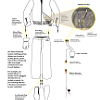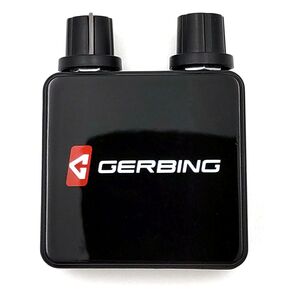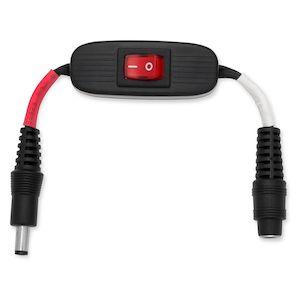“Dude, what the hell?! This is like an Easy Bake oven for my body.”
I let my buddy, Chris, ride in my heated gear and that was his initial reaction. He rambled on for quite a while through our comm systems and there were a few sailor words exchanged about how “****ing awesome!” heated gear is but I’ll refrain from detailing that commentary… yuh know… for the kids.
Chris and I used to ride together quite a bit in the mountains of North Carolina and we’d generally freeze our butts off during the colder riding season. I’ll be honest, we often went with style over function (we were noobs) and we really didn’t have a surplus of cash to spend on proper gear. We’d stack sweater after sweater, eventually start sweating, and then start freezing again once that cold air worked its way right through our sweaters and faux leather jackets. It was pretty terrible, but we were young and clueless and we loved it!
Don't be like us! If you plan to ride in cold temperatures, consider picking up some heated gear. As soon as I let Chris try my heated gear, he was kicking himself in the butt for not picking up heated gear sooner.
There’s a fair amount of stuff to cover when it comes to heated gear, so let’s start with some of the basics.

How does heated motorcycle gear work?
Inside heated gear, you’ll find a few “zones” that have very thin fibers, generally made of stainless steel and encased by a proprietary waterproof coating. Those wires are the heating elements, which may be on the chest and back of a vest, or also on the arms of a jacket, or in the fingers of heated gloves.
Those heating zones basically work like your toaster. Once power is provided to those stainless steel fibers, you get to feel all warm and fuzzy. Some heated gear is powered by its own batteries that can be recharged while most use the electrical power generated by your motorcycle. I’ll get into that more down the road.
The general principle of how heated gear works and how it gets its power is pretty much the same for every manufacturer, but they all have their own proprietary heating elements, controllers, and various accessories for their heated gear. So before you just start tossing on a bunch of heated gear, there are a few things to consider, and the first one is determining if your bike can properly power heated gear.
Can my bike support heated gear? How do I find out?
Finding out what your motorcycle can properly support when it comes to heated gear and any additional electrical farkles is very important.
Our buddy, Lemmy, did a nice little article about heated gear and how you can calculate what your bike can properly support. Rather than repeat all that here, I think you should read his explanation to get a better understanding of how to calculate your bike’s electrical capacity. Basically, you need to figure out how much electric power your motorcycle produces and how much it uses for running, so you know how much is left over to power heated gear or other added farkles, like those auxiliary lights you bolted on.
The key is not adding more heated gear than your bike can power, because being cold is no fun, but being cold and stuck alongside the road with a dead battery is even less fun.
Battery-powered versus motorcycle-powered heated gear
While most of the heated motorcycle gear on the market is designed to run off your bike's 12V electrical power, there are also options that use 7V rechargeable batteries. No connection to your motorcycle needed!
Why would you want to go that route? A few reasons. First, if you did the calculations above and you realize that your older or smaller bike doesn't have the extra juice to power heated gear, you may need to go with 7V gear. Or maybe you want to be able to use the heated gear when you're not riding. Maybe you’re a hunter sitting in a tree stand or you’re taking little Billy to soccer practice and you need to sit outside and watch him trip over the ball. Pretty much any time you might be cold and you’re not on a motorcycle, 7V heated gear can go with you. The other advantage is that you don't have to hook up anything to your ride and you're not connected to your bike. You can park and walk away without having to remember to unplug and disconnect.

Both 7V and 12V heated gear have their pros and cons. The 7V heated gear, as you might expect, can't put out as much heat and the batteries only last for so long, especially if you’re running the gear at full heat. In my experience, cut in half whatever battery time the manufacturers estimate. That might be extreme, but it's better to be safe than go on a long ride and run out of heating power while you're still far from home.
That's the obvious advantage of the 12V gear: Power is continuous as long as your motorcycle is running (or its battery has power). The downside is being tethered to the bike and having to do a little wiring.
Personally, I don’t care too much for the 7V options. I appreciate the versatility, but I personally don’t want to have to cut short the amount of time I can be on two wheels before my heated gear stops working.
Of course there are always a few outliers, such as the Tour Master Synergy BT Pro-Plus 12V Heated Jacket, which gives you the option of powering the gear by your bike's power or by a portable battery pack, sold separately. It’s actually a great option that gives you maximum versatility.
How hard is it to add heated gear to my bike?
If you know how to tighten a screw, you can add heated gear to your bike. Alright, it may not be that easy, but it’s not too far off.

Some motorcycles have a cigarette lighter-style power source for powering or charging electronic devices, such as a GPS. If you have one on your bike, you can purchase a 12V DC Plug accessory, which should allow you to power most heated gear on the market.
Another accessory commonly found on motorcycles these days, or one you can easily add, is a 12V Panel Mounted Port. Similar to the 12V DC Plug accessory, this item will allow you to run the wiring harness from your battery to any location you would like this Port to be mounted.
Once you’ve got the power figured out, the next thing you’ll need to consider, for a few manufacturers, at least, is your heat controller.
Heat controllers
Gerbing is one of the most well known manufacturers in the game of heated gear. Unfortunately, they require you to purchase a heat controller and the wiring harness separately from the heated garment you’re picking up. I’m not a big fan of having to purchase additional accessories to run my heated gear but this seems to be fairly common practice with a few brands out there.

If you don’t purchase the controller, your gear will run full blast whenever it is plugged in. The only way you’d be able to turn it off would be with an on/off switch or by simply unplugging the gear. Trust me when I say this: This heated gear is powerful and you’re not going to want it running at full blast the whole time. If the gear uses a heat controller and it’s not included, do yourself a favor and pick one up.
The other thing you’ll want to consider is whether you need a single heat controller or a dual. Nine times out of 10, I’m going to recommend getting the dual heat controller. You may only be picking up a heated jacket, but if you ever decide to add an additional item, such as a pair of pants, the dual controller will allow you to properly control the temperature of both garments independently.
How much does this stuff cost?
When I first thought about adding heated gear to my bike and I saw all the cables and the cost, I just didn’t think it was worth it. It seemed like a lot of money for those three or four months of riding and it looked cumbersome. I’ve since found that although it can get a bit costly, it’s really simple to install and use. I’ve broken down my top three favorite brands so you can get a better understanding of what a full set of gear might cost.
Hotwired
- Hotwired 12v Bluetooth Heated Jacket Liner: $220
- Hotwired 12v Bluetooth Heated Pant Liner: $200
- Hotwired 12V Heated Leather Gloves: $180
- Total = $600
Firstgear
- Firstgear Gen 4 Heated Jacket Liner: $250
- Firstgear Gen 4 Heated Pant Liner: $225
- Firstgear Rider Classic Heated Gloves: $170
- Firstgear Dual Portable Heat-Troller: $100
- Total = $745
Gerbing
- Gerbing 12V Heated Jacket Liner: $250
- Gerbing 12V Heated Pant Liner: $200
- Gerbing 12V G4 Heated Gloves: $160
- Gerbing 12V Wireless Ready Dual Temp Controller: $70
- Total= $680
Of course you don't have to buy it all. You can start with just gloves or a jacket liner and then add other items, if you feel you need them. Some people just buy a heated vest, and by keeping their core warm, the rest of the body is fine without any further electrification. It depends on the temperatures you ride in, how long you ride, and your personal tolerance for cold.
Heated motorcycle gear FAQs: Your most common questions
Q: Should I get heated gloves, heated glove liners or heated grips?
A: During my time as a Gear Geek at RevZilla, I used to get this question quite a lot. Like everything else, each option has its pros and cons, but here are some of my thoughts.
I tend to gravitate towards using heated gloves. I ride a few different bikes, so when I jump from one to another the gloves go with me. I also like how encompassing the heat feels. With that said, most heated gloves don’t provide a lot of impact protection. They’ve gotten better over the years, when it comes to protection, but I think that’s one place where heated glove liners have the upper hand. I feel like there’s a pun in there somewhere…

Glove liners allow you to use whatever gloves you want and add some heat to the party. The downside here is that they add bulk and it can often be tough to fit them inside your existing gloves. Personally, they’re just not my favorite option.
Heated grips are another simple accessory you can add to your bike and they work very well. I see more and more manufacturers including heated grips on their bikes, especially in the touring segment. Keep in mind, if you’ve got a thick winter glove that is heavily insulated, you might not feel too much of that heat coming through the grips. At the same time, the grips only heat your palms, so if you're not wearing insulated winter gloves the backs of your hands can get cold. That's one reason many riders combine heated grips with handguards to blunt the wind.
As an aside, if you decide to go with heated grips, I highly recommend the Oxford Heaterz Premium Heated Grips. They’ve got different grip patterns available, the controller is easy to read yet low-profile, and the whole kit is easy to install.
For me, I rank heated gloves as my favorite option, heated grips in second place, and heated glove liners in third. But hey, follow your heart.
Q: What should I wear underneath my heated jacket?
A: I recommend a set of base layers between you and your heated jacket. This will create a bit of space between the heating elements and your skin. Additionally, base layers will help evaporate any moisture and keep you more comfortable while you’re out on two wheels.
Q: What should I wear over my heated gear?
A: Most of this stuff is designed to be worn under your existing moto gear, so all you really need is something that is going to provide you with impact protection and abrasion resistance on top of the heated liners. You can find a few options like the Gerbing 12V EX Pro Heated Jacket that have built-in abrasion resistance and armor, but this is not as common.
Q: Heated jacket liner or heated vest?
A: I go with a heated jacket liner every time because I want all the heat I can get. Others prefer a vest because they don't want any excess material in the arms, especially if they’re already rocking a lot of layers. Both will do the important job of keeping your core nice and toasty, which maintains blood flow to your extremities.
Q: Heated socks or heated insoles?
A: Personally, unless I’m riding in really low temperatures for a prolonged period of time, I don’t utilize either. Keep in mind, everyone has a different temperature tolerance and we have different experiences with blood circulation, etc. My feet do fine with a thick pair of Smartwool socks and waterproof boots. If you want to add heat, I’d probably go with heated insoles, because I’ve heard a lot more positive feedback from fellow riders about the longevity of the insoles.
Q: Do I have to get a separate wiring harness for my gloves if I already have a heated jacket?
A: Most heated jackets on the market today will have a coax cable tucked away in a pocket on the sleeves so you can plug your gloves into your jacket to get power.

Q: What's your favorite gear, Brandon?
A: I thought you'd never ask.
There's a reason I used Hotwired, Firstgear and Gerbing in my cost examples above. Those are brands I like.
My Triumph Thruxton is my daily commuter and I ride it through the winter. The Thruxton is more or less a naked bike that’s often referred to as a hipster machine, errr, I mean a “cafe racer,” so I don't want to have to bolt on a bulky controller and mar my Thruxton's clean lines. Fortunately, one of my favorite options, the Hotwired 12v Bluetooth Heated Jacket Liner, has the three-level controller built into the jacket. I’ve got two seasons under my belt with this jacket and I’ve already been using it to kick off my third. It’s simple, comfortable, and well priced.
Firstgear and Gerbing are my two favorite alternatives, but they’re a bit more costly. If I had a larger touring bike and I planned to permanently attach controllers, I’d be more inclined to go that route. For my 30-minute commutes to the office and zipping around town, the Hotwired gear is more than adequate.
Should I get heated gear?
I’ve ridden through many winters without heated gear and I got away with it. Not comfortably, but it can be done. Will I ever go back to riding in the winter months without heated gear? Absolutely not!
Once you’ve had the sweet joy of a toaster oven covering your body during the winter, it’s hard to ride without it. That’s like eating Oreos without milk. It's still great, but once you bring a dunk of milk into the picture, well, now I can’t eat Oreos without a glass of milk. Your motorcycle is the Oreo, the milk is your heated gear — they’re simply destined to be together.
Alright, it’s getting weird, so let's just wrap it up and say that if you’re interested in stretching your riding season further, heated gear is the way to go.





























